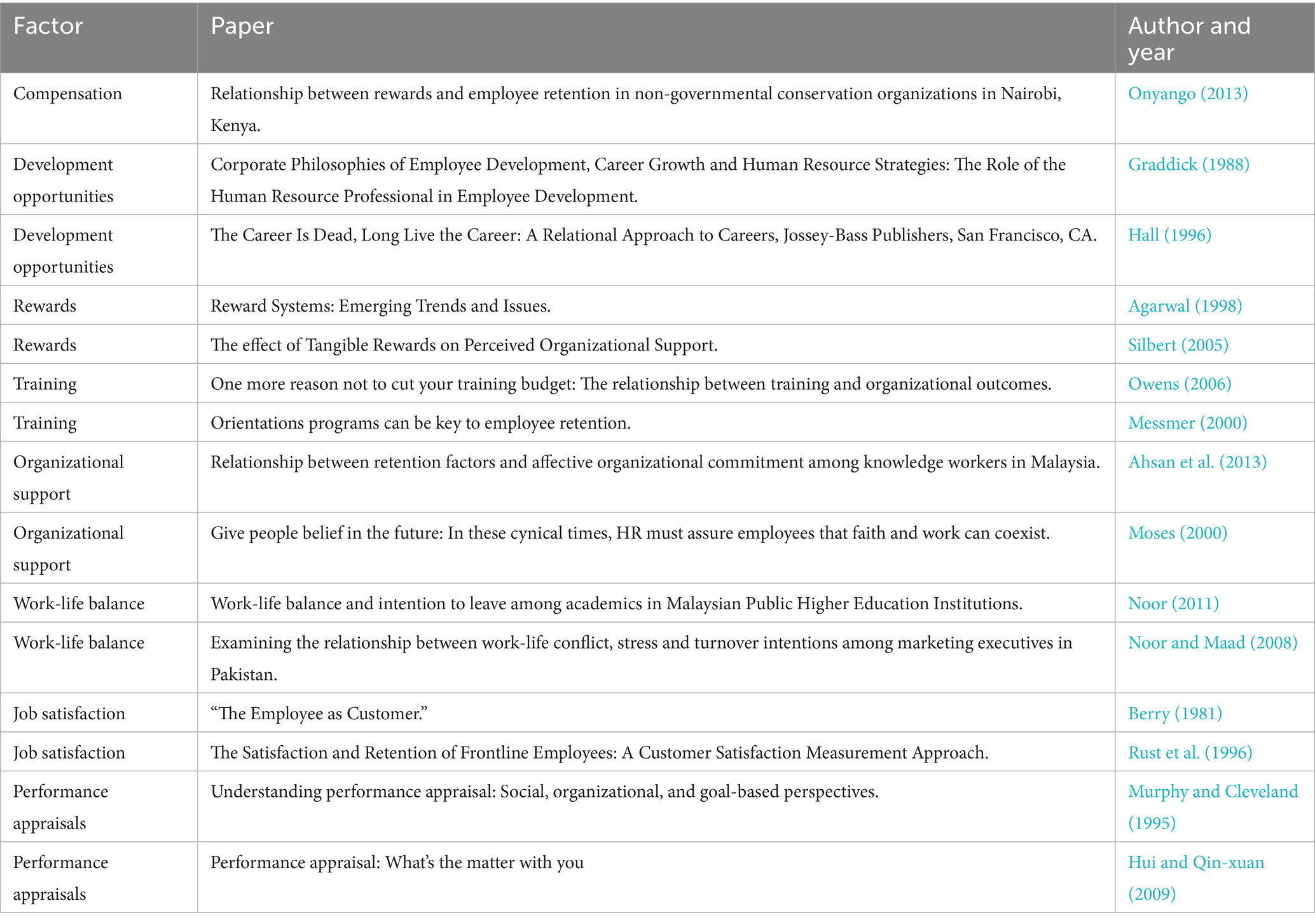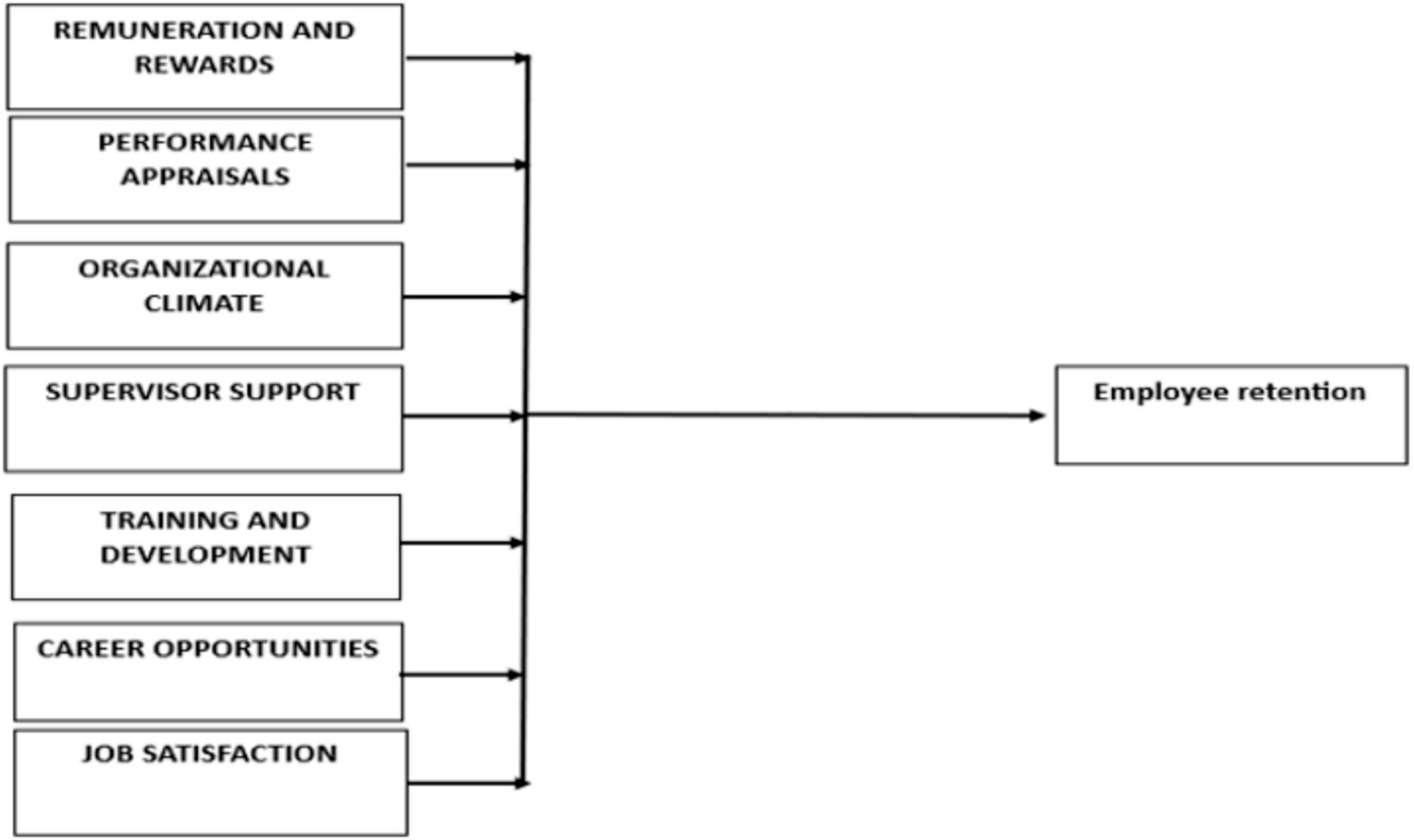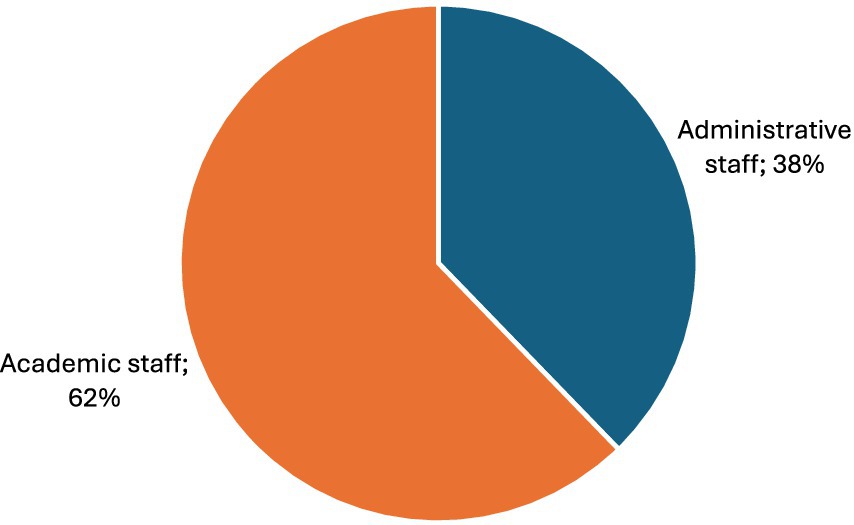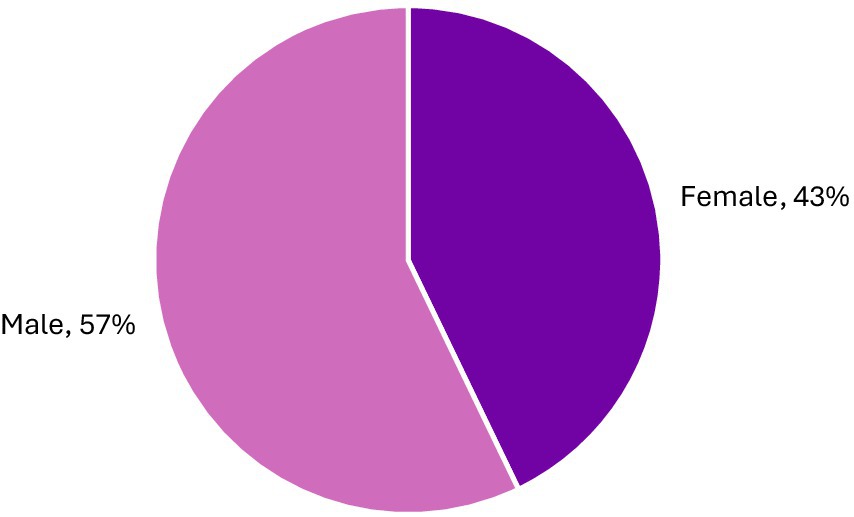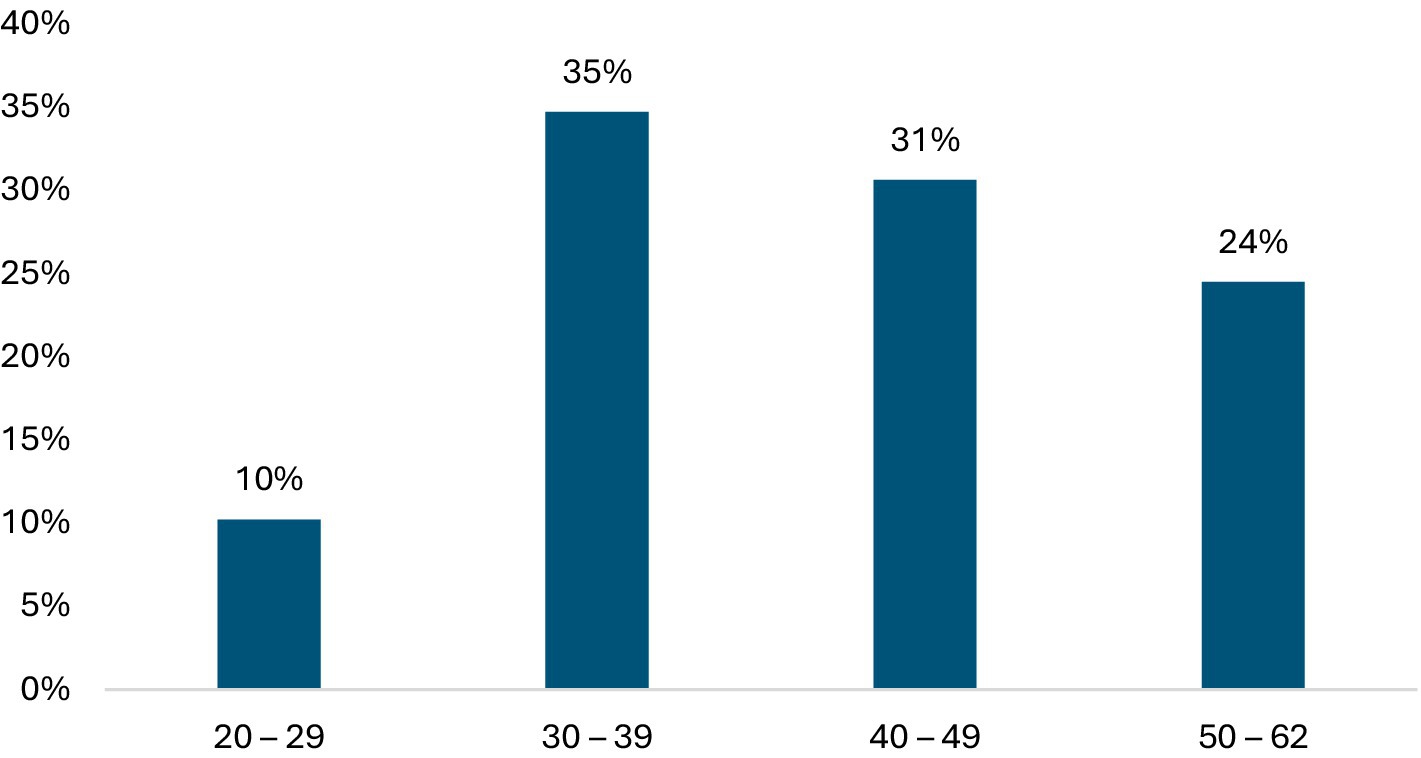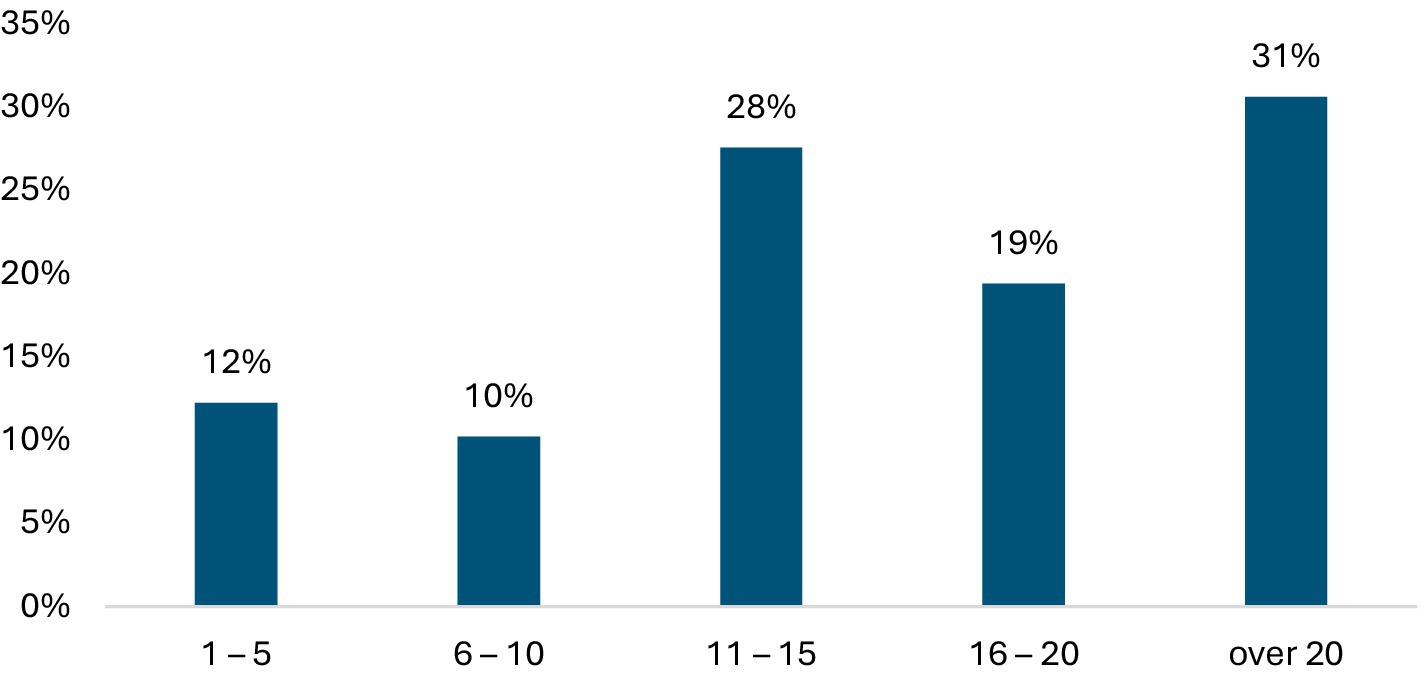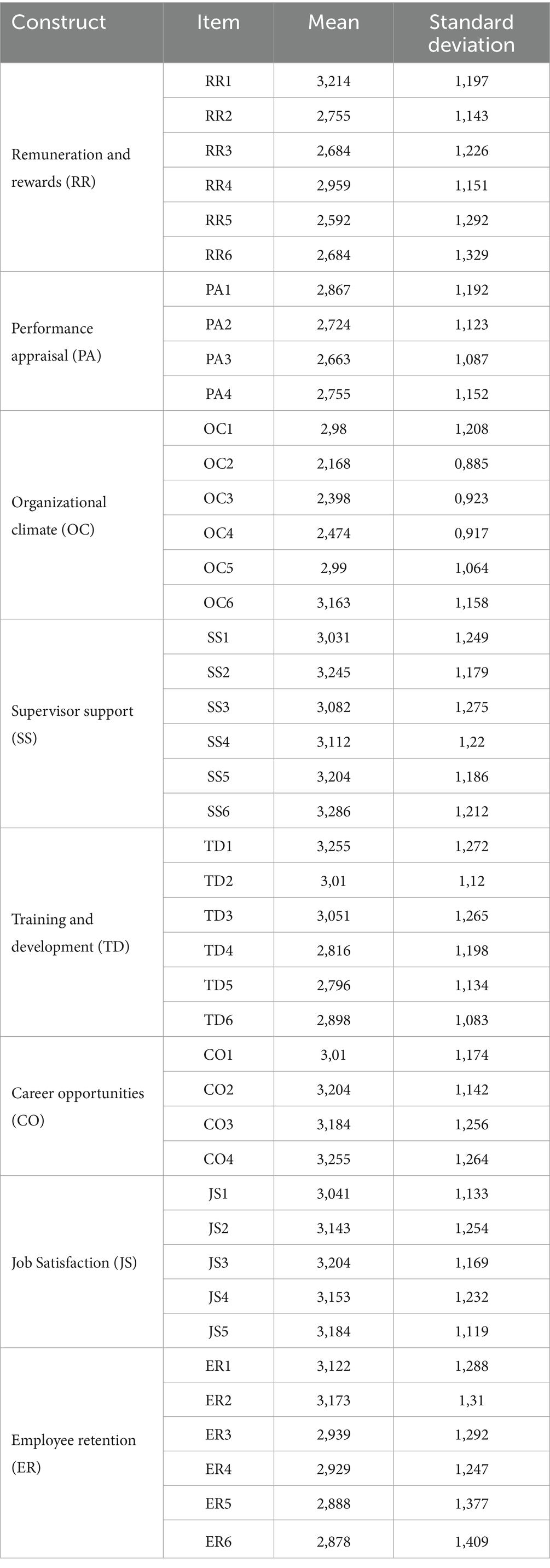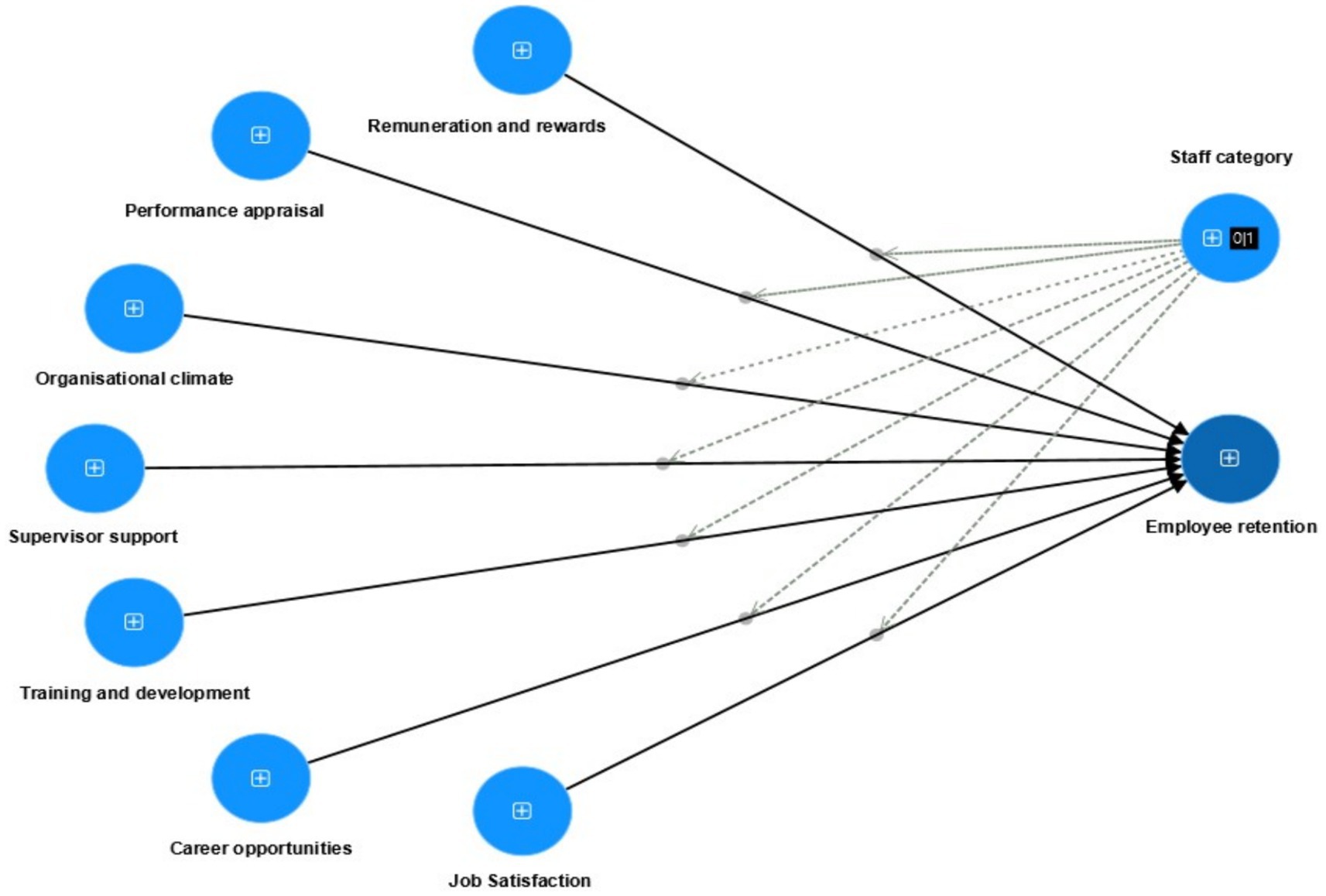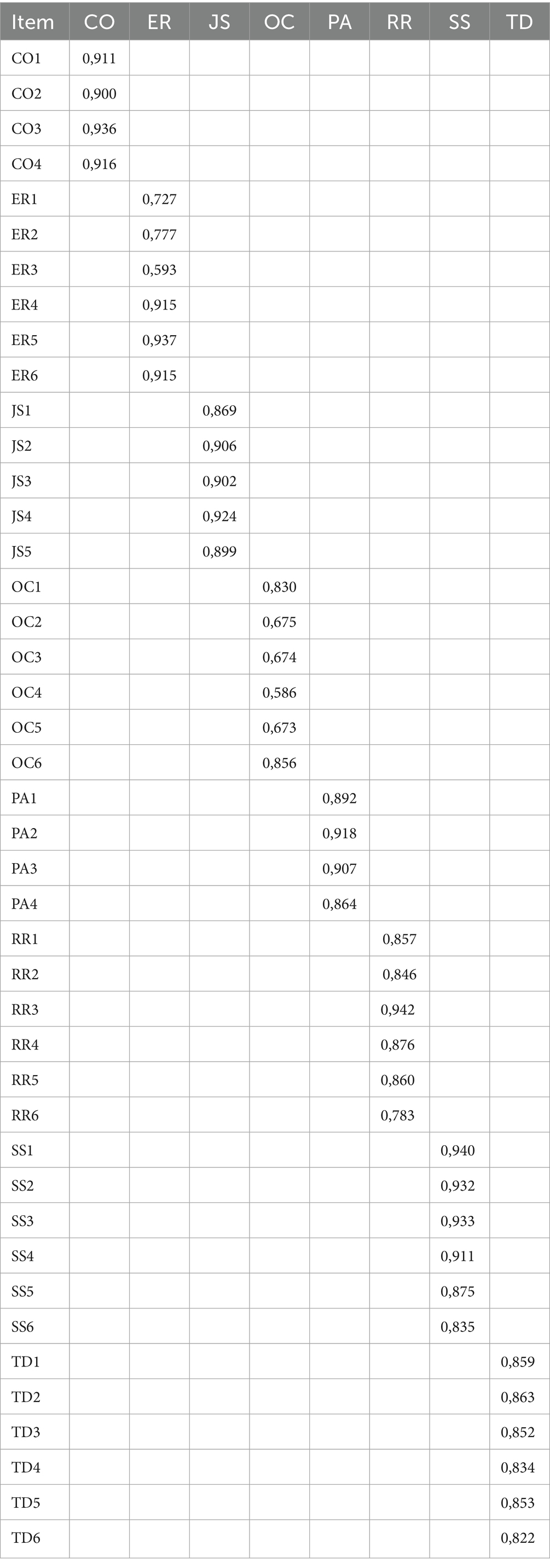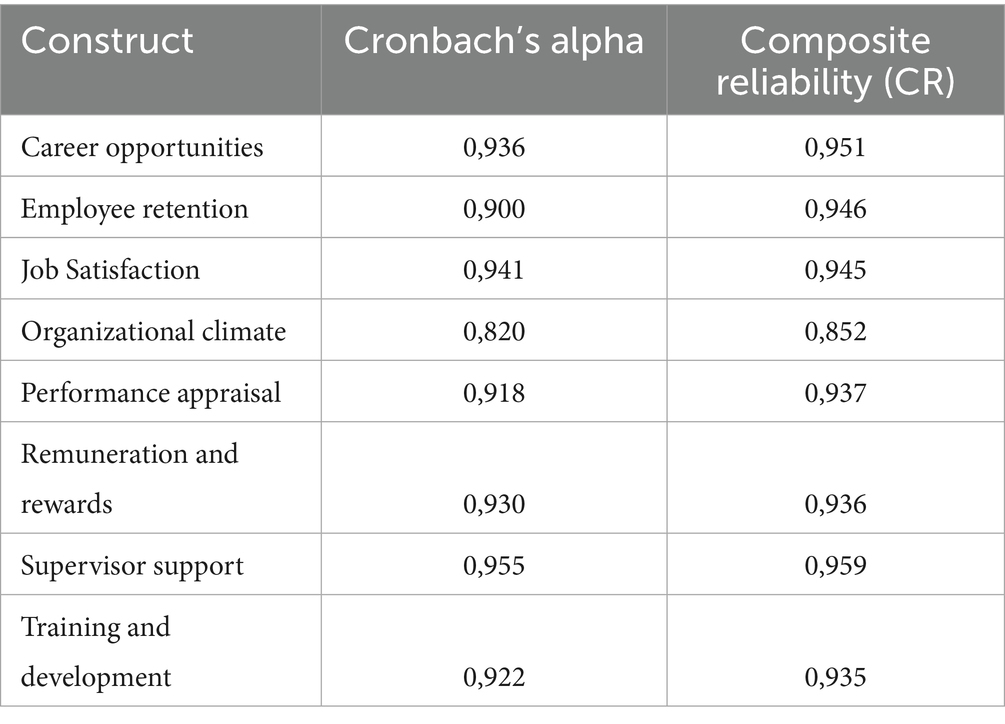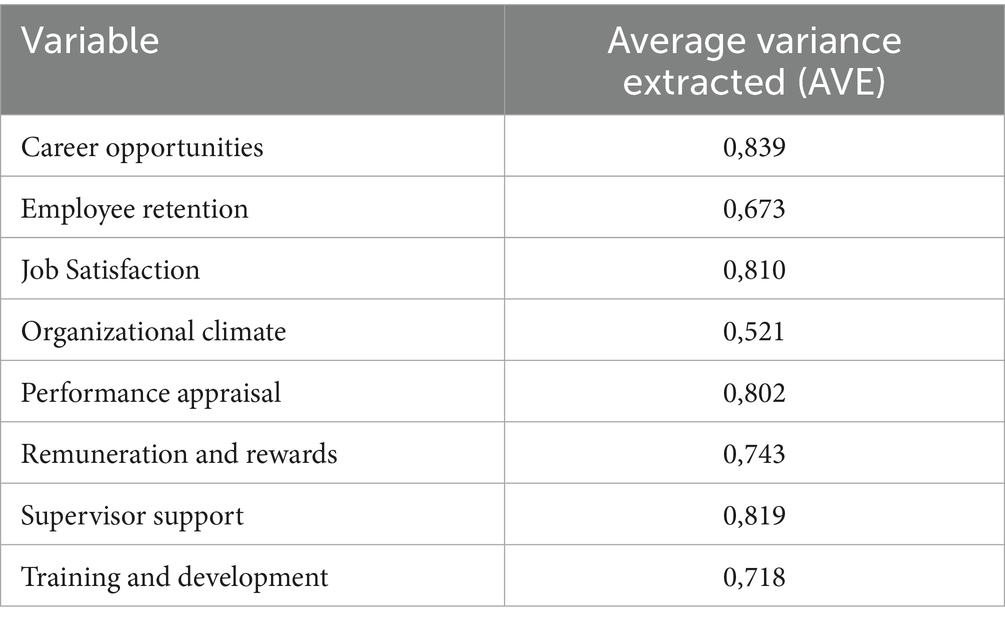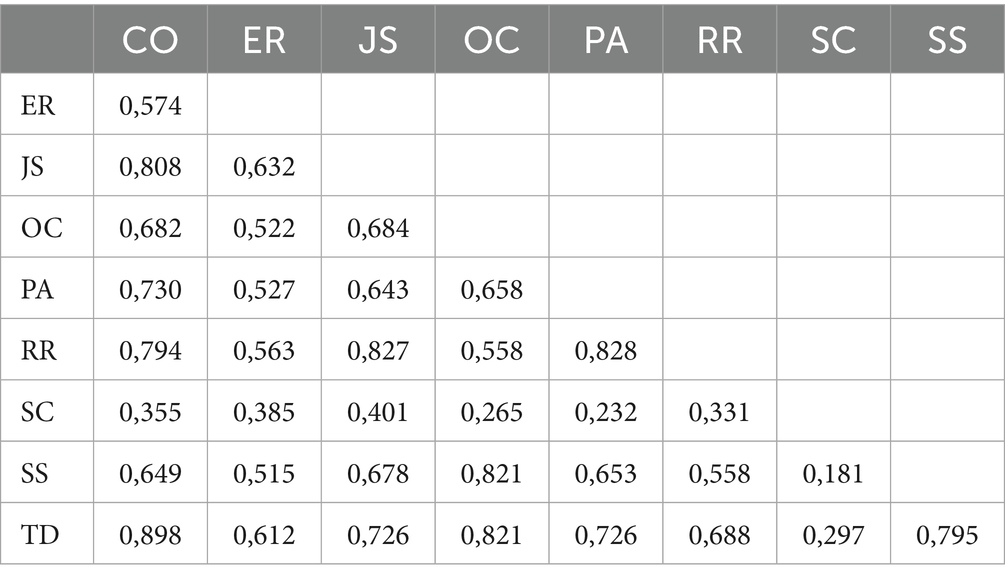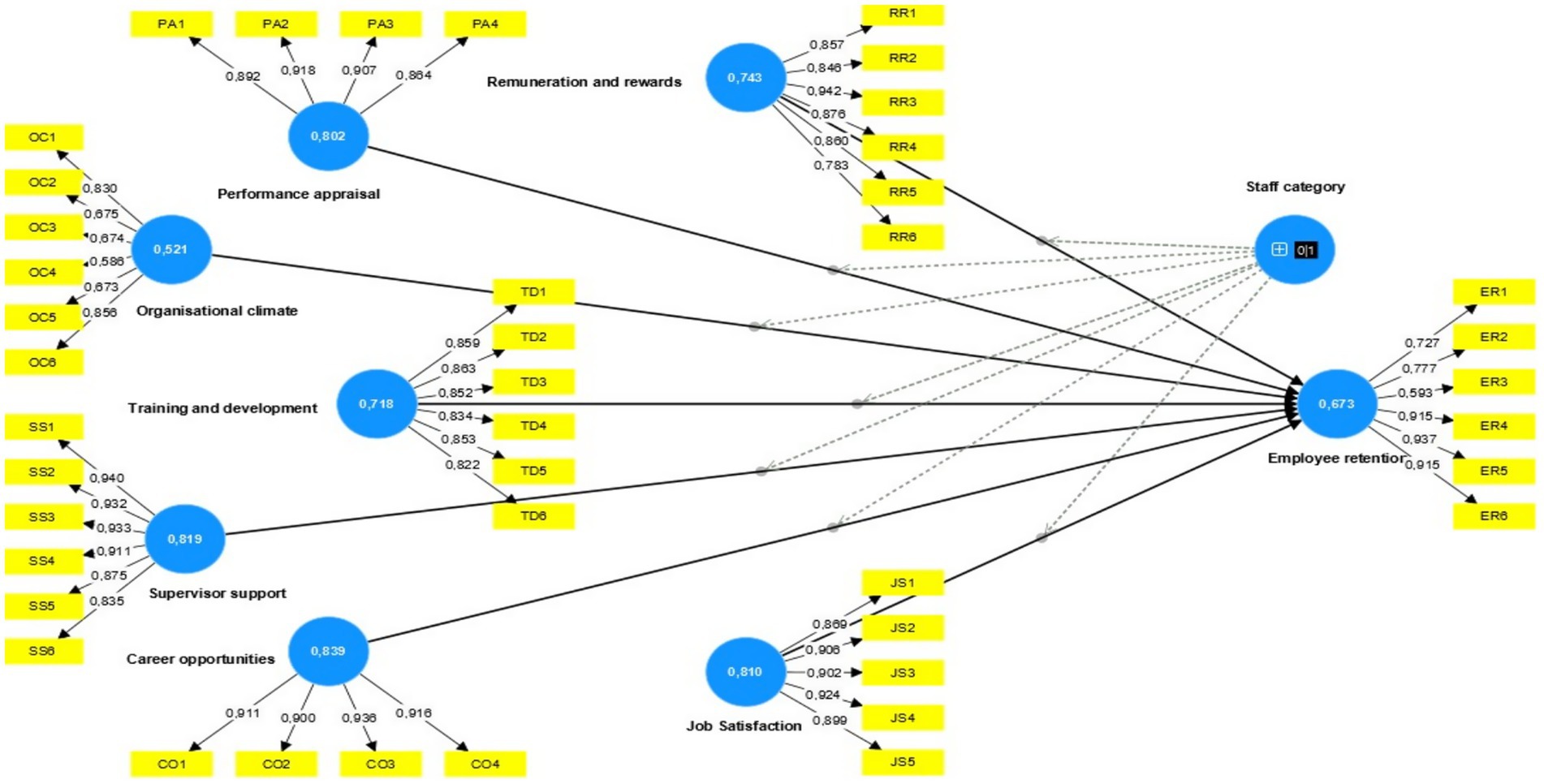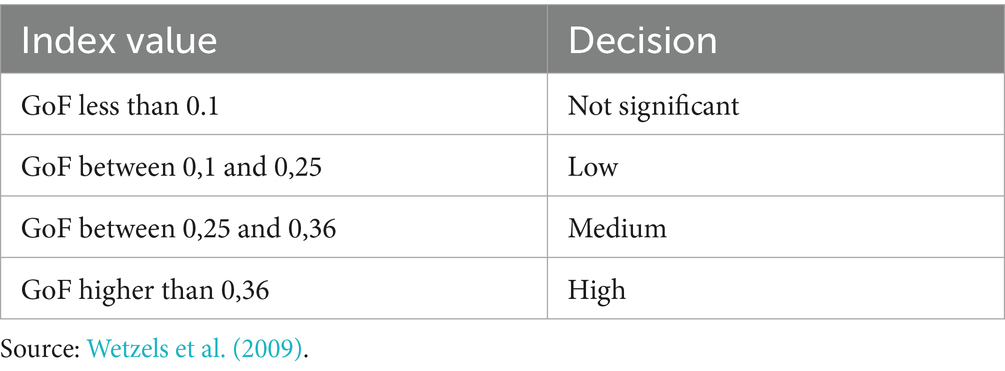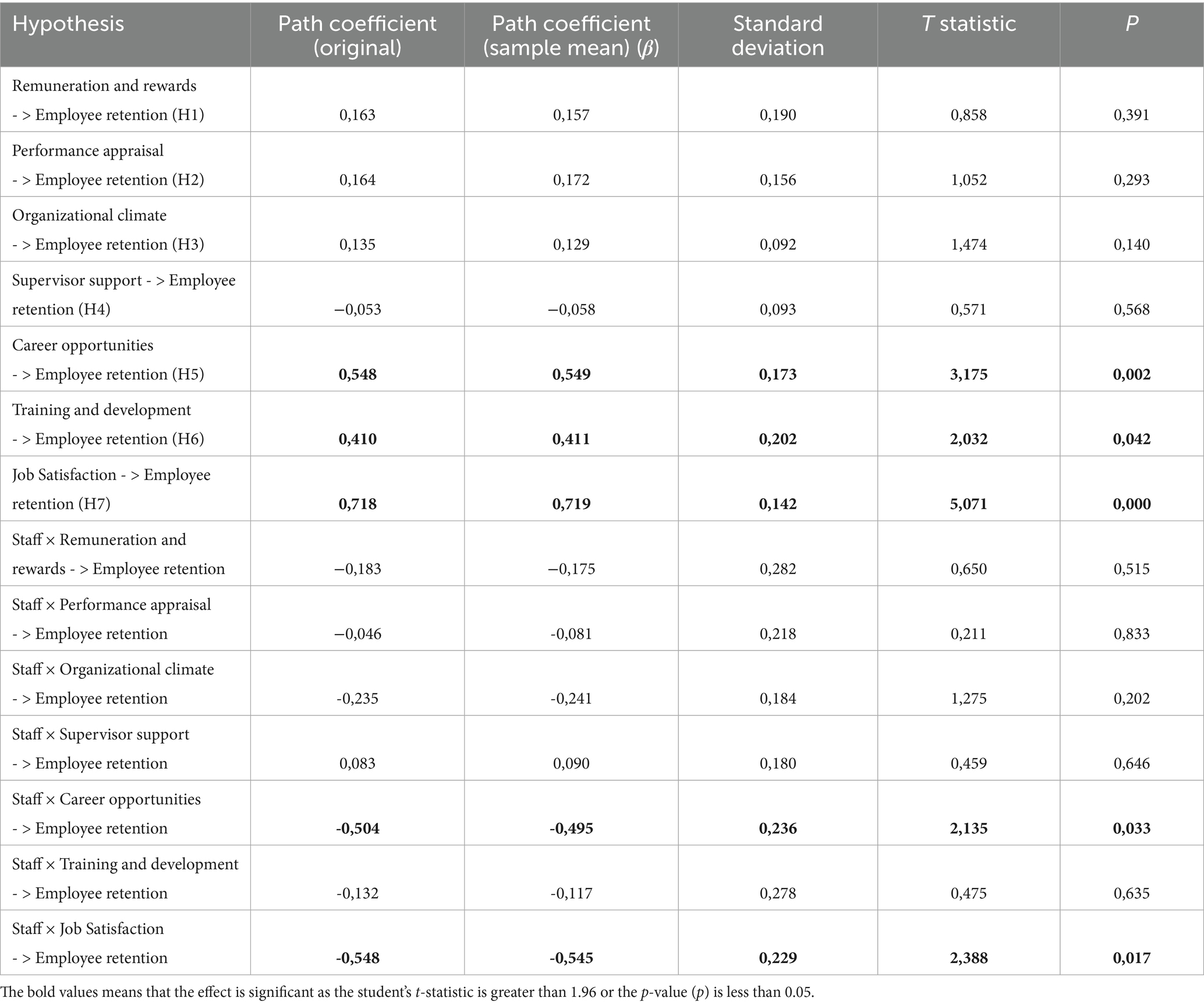- 1Universite Mohammed VI Polytechnique, Ben Guerir, Morocco
- 2Université Cadi Ayyad, Marrakesh, Morocco
This empirical study investigates the factors influencing employee retention in private higher education institutions in Morocco. Utilizing a quantitative approach, we developed and empirically tested an original conceptual framework based on primary data collected from 196 employees in these institutions. The research examines seven key factors affecting employee retention: remuneration and rewards, performance appraisals, organizational climate, supervisor support, training and development, career opportunities, and job satisfaction. The findings provide actionable insights for managers in private academic institutions, emphasizing effective employee retention strategies. Key recommendations include the establishment of career development programs, personalized growth plans, and ongoing skill development initiatives. Organizations are encouraged to conduct comprehensive needs assessments to tailor training programs emphasizing both technical and soft skills. Fostering a positive work environment, offering regular feedback, and addressing job satisfaction are essential to enhancing employee commitment, reducing turnover, and maintaining a competitive edge.
Highlights
• Training and development, career opportunities, and job satisfaction were found to significantly influence employee retention in private Moroccan academic institutions.
• Implementing robust career development programs, targeted training initiatives, and aligning employees’ professional goals with institutional objectives positively impact retention.
• Enhancing job satisfaction through recognition, a positive work environment, and growth opportunities, alongside promoting a culture of continuous learning, ensures sustainable employee engagement and retention.
1 Introduction
Retention of high-performing academics is not only a strategic HR issue but also a determinant of educational quality and institutional reputation. The history of employee retention is closely tied to the evolution of management theory, psychology, and organizational behavior. Early studies like the Hawthorne experiments in the 1920s and 1930s, led by Elton Mayo, revealed the importance of social relationships, group dynamics, and interpersonal factors in the workplace. This challenged the dominant Taylorist views and laid the foundation for the human relations movement, emphasizing positive work environments to boost employee morale and productivity. Mid-20th century research introduced key theories like Maslow’s hierarchy of needs and Herzberg’s two-factor theory, further exploring the psychological aspects of employee motivation and satisfaction.
While extensive research has been conducted on employee retention globally, little is known about the unique dynamics influencing retention in Moroccan private higher education institutions. Higher education in Morocco consists of both public and private institutions. While public universities remain the backbone of the education system, the private sector has grown in response to rising demand, offering a range of programs tailored to market needs. Employee retention plays a pivotal role in the success and sustained excellence of academic institutions. Understanding why talented staff leave or stay is critical for sustaining academic excellence and institutional growth in this competitive sector. Beyond the inherent challenges posed by the competitive labor market, retaining skilled and dedicated faculty and staff is crucial for maintaining institutional continuity, fostering a positive learning environment, and upholding academic standards.
From an HRM perspective, employee retention is deeply tied to organizational commitment, job satisfaction, and perceived career development factors that vary significantly by cultural and institutional context. Existing models often overlook the socio-economic and managerial specificities of emerging academic markets like Morocco. This research delves into the intricate landscape of employee retention within private academic institutions in Morocco, emphasizing critical factors such as remuneration and rewards, performance appraisals, organizational climate, supervisory support, training and development, career opportunities, and job satisfaction. This study contributes to literature by offering empirical insights into the drivers of academic talent retention in a non-Western, under-researched context. Employing a quantitative research methodology, the study aims to offer a comprehensive understanding of how these factors interact and collectively impact employee retention.
The research commences with the establishment of a contextual framework, followed by a meticulous literature review synthesizing existing knowledge on each factor. This comprehensive review serves as the groundwork for empirical investigation, ensuring a robust foundation for analysis. Primary data is collected through surveys, and the subsequent quantitative analysis employs statistical techniques to measure the correlation and significance of each factor concerning employee retention rates.
The research findings provide valuable insights specifically tailored for private academic institutions in the Moroccan context. It also equips HR managers in Moroccan institutions with evidence-based strategies to retain key academic staff. The thesis offers recommendations for policy adjustments, managerial interventions, and organizational initiatives grounded in empirical evidence, supplying practical guidelines to cultivate a more supportive and engaging work environment. As a result, this research serves as an invaluable resource for businesses, policymakers, and scholars seeking to unravel and address the intricacies of employee retention within private academic institutions in Morocco. By integrating local institutional realities with established HRM theories, this research bridges the gap between global models and local practices.
2 Brief literature review
The question of why employees stay with an organization has been a topic of interest for researchers for decades. Despite considerable research into employee retention, turnover remains a significant issue, especially as workers change jobs more frequently. Studies show that most employees stay in their positions for only 2 years on average, with this trend intensifying after the COVID-19 pandemic (Breytenbach, 2022).
Many studies have identified key factors influencing employee retention, with compensation, career development, and organizational culture being prominent themes. Research by Cherif (2020) and Naim and Lenka (2018) highlights that while financial incentives are crucial for retention, they represent just one aspect of the larger picture. Factors like organizational culture and work-life balance, which were often overlooked in earlier studies, have gained increased importance, especially among younger generations, who now expect a more holistic approach to job satisfaction (Imna and Hassan, 2015).
Human resources management (HRM) practices play a significant role in shaping retention outcomes. Studies on compensation, performance appraisals, and employee development show that these factors can greatly impact employees’ commitment to their employers. However, recent research suggests that retention strategies need to be tailored to meet the diverse needs and expectations of employees, which can vary across industries and cultural contexts (Malik et al., 2020; Qamar F. and Afzal, 2018; Qamar H. and Afzal, 2018).
Non-monetary benefits like medical insurance or pension plans also feature prominently in the literature. While O’Brien (2003) and Kalimanzila et al. (2019) argue that these benefits are essential for employee well-being, Kaunda and Phiri (2024) suggest that their impact is secondary to the overall compensation package, which must blend both financial and non-financial elements to effectively influence retention.
In the academic sector, retention challenges take on a unique form. Teachers and academic staff are increasingly leaving their positions due to a lack of leadership support, insufficient recognition, and poor work-life balance (Mohammad and Borkoski, 2024). These challenges are made worse by heavy workloads, which often limit staff’s ability to see long-term career benefits. Leadership and career development, therefore, emerge as critical factors that influence retention, signaling that private institutions need to focus on fostering a supportive environment for faculty to thrive.
While existing literature offers valuable insights into general retention factors, much of it is either too broad or does not address the specific challenges faced by private educational institutions in Morocco. This study aims to fill that gap by exploring how factors such as leadership quality, career growth, and organizational climate impact retention among staff at Moroccan private universities.
3 Research hypothesis
The present paper has developed a conceptual framework that is expected to offer reliable information as to which factors affect employee retention.
3.1 Remuneration and rewards and employee retention
Research indicates that competitive and fair remuneration is strongly linked to improved employee retention. Trevor et al. (1997) found that pay increases reduce turnover, while Davies et al. (2001) emphasized that strategic salary and benefits enhance morale and retention. Gardner et al. (2004) and Milkovich and Newman (2008) highlighted the importance of monetary rewards in retaining employees. Performance-based pay also boosts retention (Nazir et al., 2013). Research also shows reward systems, including performance-based incentives, improving job satisfaction and retention (Gneezy et al., 2019).
Hypothesis 1: Remuneration and rewards have a positive impact on employee retention.
3.2 Performance appraisals and employee retention
Performance appraisal systems are vital for enhancing employee retention and commitment by identifying strengths and weaknesses while outlining growth opportunities. Effective performance appraisals help meet organizational objectives and improve employee performance, leading to increased commitment and loyalty (Gruman and Saks, 2011). A transparent and fair appraisal system boosts motivation, providing equal opportunities for career advancement (Azeez, 2017). Studies show that effective performance appraisals have a substantial positive impact on retention in various contexts, including hospitals and IT organizations (Rao et al., 2018).
Hypothesis 2: Performance appraisals have a positive impact on employee retention.
3.3 Organizational climate and employee retention
Organizational climate encompasses the shared beliefs, values, and assumptions among members within an organization, shaping behaviors and interactions (Marcoulides and Heck, 1993). Research highlights the importance of aligning individual values with organizational values to enhance belonging and reduce turnover intentions (Schneider, 2000). A positive organizational culture correlates with higher employee morale and efficiency, emphasizing the need for organizations to cultivate an inclusive and supportive climate to improve retention (Arunchand and Ramanathan, 2013).
Hypothesis 3: Organizational climate has a positive impact on employee retention.
3.4 Supervisor support and employee retention
Supervisors play a vital role in shaping the work environment by overseeing subordinates and effectively communicating organizational goals and values (Suifan et al., 2018). Strong supervisory relationships often foster commitment to the organization, as employees may view their supervisors as mentors, reinforcing the principles of Social Exchange Theory (Newman et al., 2012). Numerous studies have demonstrated a positive relationship between supervisory support and employee retention across various industries (Tuzun and Kalemci, 2012).
Hypothesis 4: Supervisor support has a positive impact on employee retention.
3.5 Career opportunities and employee retention
Research consistently demonstrates a positive correlation between career growth opportunities and employee retention. Pergamit and Veum (1999) found that promotions are closely linked to retention, while Meyer and Herscovitch (2001) identified internal career growth as a key predictor of employee commitment. Prince (2005) noted that talented employees seek career advancement to maintain a competitive edge, highlighting the need for structured advancement plans and accurate career previews during hiring. Allen et al. (2010) reinforced this by showing that tangible prospects for progression significantly influence retention.
Hypothesis 5: Career opportunities have a positive impact on employee retention.
3.6 Training and development
Implementing effective employee retention strategies demands ongoing efforts rather than isolated initiatives. Sinha and Sinha (2012) emphasize that training is a crucial retention factor for employees of all ages. Lusewa (2015) underscores the importance of training programs in enhancing retention rates. In a study by Duah and Danso (2017) focused on Ghana’s Capital Bank, employees identified training as a significant influence on their decision to stay, directly linking it to their job performance. Research by Jaseel (2019) highlights the connections between training, job satisfaction, and wages, indicating that effective training contributes to employee retention and overall organizational performance. Nguyen (2020) further identifies training as a key factor influencing retention among young employees.
Hypothesis 6: Training and development have a positive impact on employee retention.
3.7 Job satisfaction
Job satisfaction pertains to the degree to which employees value their jobs based on factors they find favorable (Spector, 1997). Cronley and Kim (2017) describe it as a pleasurable emotional state that employees assess and perceive based on what they derive from their job in aiding them to attain job goals and values. Previous research indicates a positive correlation between job satisfaction and employee retention, revealing that higher job satisfaction levels are linked to higher rates of employee retention. Satisfied employees are more likely to exhibit positive attitudes and favorable work outcomes (Suifan et al., 2017).
Hypothesis 7: Job satisfaction has a positive impact on employee retention.
4 Research methodology
4.1 Population and sample
The current study is empirical, explanatory, deductive, and quantitative in nature. This research study targeted teaching and non-teaching employees at private higher education institutions and universities of Morocco.
4.2 Data collection instrument
The survey method of data collection was used in this research. Scheuren (2004) defines a survey as a research method for collecting information from a selected group of people using standardized questionnaires or interviews. In the study, a structured questionnaire was used to collect data from the respondents. Before administering the survey to the entire sample, a pilot test was conducted with a small group of university staff members to evaluate the clarity and effectiveness of the questions. Feedback from the pilot study was utilized to refine the questionnaire, including adding or removing questions as needed. Respondents participated voluntarily in the survey, and the finalized questionnaire, modified based on pilot study insights, was distributed from December 2022 to March 2023, lasting approximately 4 months. Paper-based questionnaires were distributed, and electronic versions were shared through online channels based on respondent accessibility.
4.3 Measurement and analysis of data
For this study, a modified Likert-type scale was used with the General Self-Efficacy Exam to measure the impact of seven factors: remuneration and rewards, performance appraisals, organizational climate, supervisory support, training and development, career opportunities, and job satisfaction on employee retention in academia.
Likert-Type Scales Likert scales provide a range of responses to a statement or series of statements. Usually, there are 5 categories of response ranging from 5 = strongly agree to 1 = strongly disagree with a 3 = neutral type of response (Jamieson, 2004).
4.4 Measurement scale
A measurement scale for employee retention is a structured tool designed to assess and quantify various factors that influence an employee’s decision to stay with or leave an organization. In our study we have used a questionnaire which is adapted from different studies (Table 1). The scale has been validated in the study of Chatzoudes and Chatzoglou (2022) in their paper “Factors Affecting Employee Retention: Proposing an Original Conceptual Framework. International Journal of Economics and Business Administration Volume X, Issue 1, 49–76.”
4.5 Measurement items
Several studies have been conducted in the field of employee retention, but there is no precise measurement scale that has been developed. In the context of our research work, we have selected, for these variables, the measurement scale that was created as part of a study conducted by (Chatzoudes and Chatzoglou, 2022) in their paper “Factors Affecting Employee Retention: Proposing an Original Conceptual Framework. International Journal of Economics and Business Administration Volume X, Issue 1, 49–76.,” we will consider seven factors and 44 items.
4.6 Research model
The conceptual framework was developed by thoroughly examining the existing literature on employee retention. The research model, illustrated in Figure 1, integrates eight variables and their corresponding hypotheses extracted from the preceding section. The primary aim of this research model is to investigate the correlation between the identified factors and the employee retention.
5 Results analysis
5.1 Descriptive analysis
Descriptive analysis involves process of transforming data of general characteristics. In this study, descriptive analysis described and summarized the respondent demographic consists of gender, age, education level and working experience. The analysis was generated from collected questionnaire data or information.
Our study of 196 subjects unveils a diverse composition of staff, with 38% dedicated to administrative roles and 62% engaged in academic pursuits. The gender distribution is even, with 43% female and 57% male participants. Age diversity is evident, ranging from 20 to 62 years, capturing perspectives across various life stages. Professional experience is well-represented, with 69% having 1 to 20 years of experience and 31% possessing over 20 years of experience, providing a comprehensive view of career stages. Education levels showcase a majority (65%) with qualifications beyond BAC + 5, highlighting an emphasis on advanced degrees. These insights collectively contribute to a nuanced understanding of the sample’s demographics, professional backgrounds, and educational diversity, enhancing the richness of our study.
5.1.1 Distribution by staff category
The data implies that 38% of the staff falls under the administrative staff, which typically includes roles responsible for the organization’s day-to-day operations, management, and support functions. On the other hand, the majority, 62%, consists of academic staff, suggesting a significant focus on educational and research-related roles (Figure 2).
5.1.2 Distribution by gender
Our sample is characterized by a gender distribution of 43% female and 57% male (Figure 3).
5.1.3 Distribution by age
Our sample exhibits a diverse age distribution, capturing a range of perspectives across different life stages. Individuals in the 20–29 age group constitute 10% of our participants, followed by a significant presence in the 30–39 at 35%. The cohort aged 40–49 comprises 31% of our sample, while those between 50 and 62 years old make up the remaining 24% (Figure 4).
5.1.4 Distribution by years of experience
Our sample encompasses a broad spectrum of professional experience, highlighting a wealth of insights from individuals at various career stages. Participants with 1–5 years of experience constitute 12% of our cohort, while those with 6–10 years represent 10%. The majority of our sample falls within the 11–15 years, comprising 28%, followed by a notable presence of individuals with 16–20 years of experience at 19%. Additionally, a group with over 20 years of experience makes up the remaining 31% (Figure 5).
5.2 Average scores of items
Before proceeding with the analysis and for the sake of clarity in presenting the various results, we conducted a coding process for all items and constructs, the coding of which is presented in Table 2.
Overall, all items have an average around 3 on a 5-point Likert scale, indicating that our sample is, on average, neutral toward all measured items.
• Remuneration and rewards (RR)
RR1 to RR6 have averages ranging from 2.592 to 3.214. Except for item RR1, the other items have average scores below 3, indicating that overall, employees had a slightly unfavorable perception of compensation and rewards.
• Performance appraisal (PA)
PA1 to PA4 have averages between 2.663 and 2.867, indicating that, on average, employees had a slightly unfavorable perception of performance evaluation.
• Organizational climate (OC)
OC1 to OC6 have averages between 2.168 and 3.163, indicating variability in the perception of organizational climate. OC2 (Co-workers are trusting, friendly, and co-operative) appears to be particularly low. This dimension also records the least dispersed responses with standard deviations below 1 for items OC2, OC3, and OC4.
• Supervisor support (SS)
SS1 to SS6 have averages between 3.031 and 3.286, showing a generally positive perception of supervisor support.
• Training and development (TD)
TD1 to TD6 have averages between 2.796 and 3.255, indicating a rather neutral to positive perception of training and development.
• Career opportunities (CO)
CO1 to CO4 have averages between 3.01 and 3.255, indicating a rather positive perception of career opportunities.
• Job Satisfaction (JS)
JS1 to JS5 have averages between 3.041 and 3.204, indicating a rather positive perception of job satisfaction.
• Employee retention (ER)
ER1 to ER6 have averages between 2.878 and 3.061, indicating an overall slightly unfavorable perception of employee retention.
5.3 Confirmatory factor analysis
In this study, we will adopt the PLS approach. It is based on the partial least squares method and is less sensitive to sample size and data non-normality. It is implemented using SmartPLS 4.0.9.7 software (Figure 6). All items from different constructs are in the format of a five-point Likert scale. The first three items of the employee retention construct were reversed. Therefore, a recording was performed to ensure that all items in this construct had the same directional relationship with the construct of interest before undertaking statistical analyses.
5.4 Measurement model evaluation
The measurement model aims to establish the validity and reliability of the elements of the constructs. The analysis includes the reliability of individual indicators, where the factor loading of items should be greater than 0.40. The internal consistency reliability is calculated using Cronbach’s Alpha and the composite reliability (CR), both of which should exceed 0.70. Convergent validity is assessed through the average variance extracted (AVE), which should be greater than 0.50. Discriminant validity is evaluated using the heterotrait-monotrait ratio (HTMT), which should be less than 0.90.
5.4.1 Indicator reliability
It is interesting to note that the results of the PLS algorithm in this study showed that the values of Cronbach’s Alpha and CR for all latent variables ranged between 0.820 and 0.959 (results presented in Tables 3, 4). Thus, all studied latent variables have reached and exceeded the acceptable reliability threshold of 0.70. The internal consistency of all latent variables is therefore confirmed.
5.4.2 Convergent validity
In the context of this study, the AVE values for all constructs ranged between 0.521 and 0.839 as presented in Table 5. Therefore, the study’s AVE results exceeded the recommended threshold value of 0.50, indicating satisfactory convergent validity.
5.4.3 Discriminant validity
The threshold value for the HTMT approach should be less than 0.90 to achieve discriminant validity. In this study, the HTMT results presented in Table 6 show that all values are below the recommended threshold of 0.90. Therefore, discriminant validity for all constructs has been established.
The results of the measurement model evaluation indicate that the measurement elements are reliable and valid, meaning that they accurately measure the constructs they are supposed to measure (Figure 7). This allows us to move on to the next step of the analysis, which involves assessing the structural model and testing the research hypotheses.
5.5 Evaluation of the structural model
The following subsections address the index used to assess the validity of the structural model in this research, which requires an examination of the GoF (Goodness Of-Fit) index proposed by Tenenhaus et al. (2005) to evaluate the quality of the structural model. Next, the Bootstrapping resampling method was used to generate 5,000 samples from the 196 cases, useful for generating t-statistics and p-values necessary to determine the significance of the significant impact of an independent variable on the dependent variable (employee retention) as well as the moderating effects of staff category.
To assess the validity of the GoF index, Wetzels et al. (2009) considered the criteria presented in the Table 7 to determine the degree of significance of the GoF.
The coefficient of determination (R2), a statistical measure indicating the proportion of the variance in the dependent variable explained or predicted by the independent variables in a model, is approximately 0.49 in our study. The independent variables under study explain 49% of the variance in employee retention.
Using the GoF index formula, we obtain a value of GoF = 0.604, which is greater than 0.36. We can conclude that the PLS model is broadly valid, and the overall quality of our research model is satisfactory. Next, we will examine the causal links in the structural model to corroborate or refute our research hypotheses.
5.6 Study of links of causality
To test our research hypotheses, we will carefully examine the student’s t-statistic values and/or p-values (Table 8), determining the significance of the links between the independent variable and the dependent variable.
The absolute value of the path coefficient (β) informs us about the intensity of the effect, and its sign indicates the direction of the effect. In the case of a positive sign, we refer to a positive effect, whereas the effect is negative if the sign is negative.
We set the significance threshold at 5%. In other words, we consider an effect to be significant if the student’s t-statistic is greater than 1.96 or the p-value (p) is less than 0.05.
The evaluation of the significance of the relationships and developed hypotheses has shown that compensation and rewards do not significantly affect employee retention (β = 0.157, t = 0.858, p = 0.391). Consequently, hypothesis H1 is rejected. Additionally, the results have demonstrated that performance evaluation has no influence on employee retention (β = 0.172, t = 1.051, p = 0.293). Therefore, hypothesis H2 is statistically refuted. Similarly, the obtained results do not confirm hypotheses H3 and H4; organizational climate does not significantly influence employee retention (β = 0.129, t = 1.474, p = 0.140), and supervisor support does not significantly impact employee retention (β = −0.058, t = 0.571, p = 0.569).
On the other hand, career opportunities positively and significantly impact employee retention (β = 0.549, t = 3.175, p = 0.002). Therefore, the proposed hypothesis (H5) is accepted. Furthermore, the results have shown that training and development have a statistically significant positive influence on employee retention (β = 0.411, t = 2.032, p = 0.042). Consequently, hypothesis (H6) is statistically confirmed. Similarly, the obtained results also confirm hypothesis (H7); job satisfaction significantly and positively influences employee retention (β = 0.719, t = 5.071, p < 0.001).
6 Discussions of research findings
6.1 Effect of remuneration and rewards on employee retention in Moroccan private academic institutions
Our study indicates that within private higher education institutions and universities in Morocco, there is no positive correlation between employee retention and remuneration and rewards. In the Moroccan context, several factors may help explain this lack of association. Academic staff in private institutions often place higher value on non-monetary aspects of their professional lives, such as intellectual autonomy, access to research opportunities, and institutional reputation. The motivational effect of remuneration may also be diminished due to relatively homogeneous salary structures and limited financial incentives across institutions. Furthermore, aspects such as organizational culture, job stability, leadership quality, and reciprocal relationships tend to exert a stronger influence on retention decisions. These elements contribute more significantly to an individual’s sense of fulfillment and professional belonging than financial compensation alone, particularly within the academic sector. Other researchers have similarly found only a weak positive relationship between compensation and employee retention. Chiekezie et al. (2017), for instance, identified a modest correlation between salary and employee satisfaction in selected banks in Anambra, specifically within the Awka metropolis. This observation is consistent with the findings of Msengeti and Obwogi (2015), who concluded that pay has only a limited effect on employee retention, whereas the work environment plays a more influential role.
6.2 Effect of performance appraisal on employee retention in Moroccan private academic institutions
The research revealed a disconnect between employee retention and performance appraisal in Moroccan private higher education institutions and universities. Several contextual factors may account for this divergence. In many private academic institutions, performance appraisals may be viewed as routine administrative exercises rather than meaningful developmental tools. When appraisal processes lack transparency, consistency, or clear link to career advancement, employees are less likely to perceive them as valuable or motivating. Additionally, when appraisals are not accompanied by constructive feedback, professional support, or tangible rewards, their impact on employee engagement and long-term commitment is significantly diminished. In academic settings, where staff value recognition for their research and ideas, formal evaluations often fail to reflect what truly motivates them. Consequently, the limited strategic use of appraisals in these institutions contributes to their ineffectiveness in enhancing employee retention. Our results align with the findings of Imna and Hassan (2015), who similarly reported no significant influence of performance appraisal on employee retention. This stands in contrast to the view of Mondy and Noe (2005), who emphasize the essential function of performance appraisal in monitoring employee progress and fostering retention. While other researchers highlight the positive impact of effective performance evaluation systems on employee motivation and organizational commitment, the findings of this study suggest otherwise within the Moroccan context.
6.3 Effect of organizational climate on employee retention in Moroccan private academic institutions
The results of the study indicate that there is no positive impact of organizational climate on employee retention within Moroccan private higher education institutions and universities. This lack of correlation may be attributed to several underlying factors specific to the academic context. In many private institutions, frequent leadership changes, limited involvement in decision-making, and poor communication can make the work environment feel unstable. When staff see the institution as lacking transparency, support, or inclusion, small improvements on the surface may not be enough to rebuild trust or meet their deeper professional needs. Moreover, academic employees often prioritize factors such as research autonomy, job security, and career development opportunities over the general workplace atmosphere. In such settings, even a positive organizational climate may be insufficient to counteract wider structural limitations, such as unclear promotion pathways or contractual precarity, which can weigh more heavily in decisions to remain with or leave an institution. This suggests that efforts to enhance organizational climate may not necessarily translate into improved retention outcomes. These findings are consistent with those of Frimayasa (2021), who also reported no significant effect of the work environment on employee retention.
6.4 Effect of supervisory support on employee retention in Moroccan private academic institutions
The findings of this study indicate that there is no statistically significant positive impact of supervisory support on employee retention within Moroccan private higher education institutions and universities. The divergence in findings may be explained by contextual and cultural differences within organizational structures. In Moroccan private universities, the relationship between supervisors and academic staff is often formal and focused on administration, rather than building mentorship or strong professional connections. As a result, staff may see their supervisors more as managers than as sources of support or career guidance. When support from supervisors does not translate into tangible benefits such as improved working conditions, access to resources, or career progression it is unlikely to serve as a decisive factor in employee retention. This result is consistent with prior research that identified either a weak or negative association between supervisory support and retention outcomes. For example, Cho et al. (2009) found that even in contexts where supervisor support was perceived as high, it did not correspond to an increased intention among employees to remain within the organization. However, these findings stand in contrast to studies such as Zafar (2015), both of which reported a significant positive relationship between supervisor support and employee retention, suggesting that in some organizational contexts, supervisory support can play a critical role in influencing employees’ decisions to stay.
6.5 Effect of training and development on employee retention in Moroccan private academic institutions
The research has established a significant positive correlation between training and development initiatives and employee retention within private Moroccan higher education institutions and universities. In the Moroccan context, where career advancement prospects may be limited, professional development initiatives are often perceived as a vital pathway for growth and self-improvement. Access to continuous learning and skill-building not only increases employees’ capabilities but also strengthens their sense of belonging and engagement with the institution. When individuals perceive that their organization is invested in their professional future, they are more likely to exhibit organizational loyalty and a reduced intent to leave. Moreover, such initiatives can compensate for limitations in other retention factors, such as remuneration or job security, by fostering a culture of growth, recognition, and long-term potential. This finding is consistent with previous studies emphasizing the critical role of professional development in fostering long-term employee commitment. Bibi et al. (2018) findings showed that employee retention was significantly influenced by training and development as well as supervisor support. Mondy and Noe (2005) argue that structured organizational initiatives such as job training, coaching, mentoring, and counseling play an essential role in enhancing employees’ skills and knowledge, thereby contributing to their sense of support and value within the institution. Similarly, Akala (2012) highlights that retention of non-teaching staff at the University of Nairobi can be effectively improved through equitable and transparent access to training and development opportunities.
6.6 Effect of potential for career opportunities on employee retention in Moroccan private academic institutions
The study demonstrated a clear and positive correlation between the potential for career advancement and employee retention within Moroccan private higher education institutions and universities. In the context of Moroccan private academic institutions, the opportunity for career progression is a critical determinant of retention, particularly in an environment where academic roles can often be characterized by limited upward mobility. When employees perceive that there are clear, attainable pathways for growth whether through promotions, expanded responsibilities, or opportunities for leadership they are more likely to remain engaged and committed to the institution. The presence of structured career development initiatives signals institutional investment in long-term talent retention. This sense of progression and recognition contributes to a more stable and motivated workforce. This finding aligns with Prince (2005), who emphasizes that career development programs central to strategic human resource management play a crucial role in shaping employees’ professional trajectories by identifying the competencies necessary to pursue long-term career goals and sustain their engagement within the organization.
6.7 Effect of job satisfaction on employee retention in Moroccan private academic institutions
The study’s findings indicate that enhanced job satisfaction significantly contributes to increased employee retention within Moroccan private higher education institutions and universities. Research shows a clear link between job satisfaction and employee retention when people are happy at work, they are more likely to stay. Suifan et al. (2017) found that satisfied employees are usually more positive, engaged, and productive, which helps create a stable work environment. In Moroccan private universities, job satisfaction often depends on feeling aligned with the institution’s values, being recognized for one’s work, and having the chance to do meaningful tasks. When these needs are met, staff are more loyal and less likely to leave. This matches Biason’s (2020) findings, which also highlight job satisfaction as key to retaining staff. Jones and George (2002) further point out that low satisfaction can lead to absenteeism, a common early sign that someone might be thinking about quitting. Lo and Punzalan (2025) highlight the role of non-monetary and positive psychology strategies in enhancing employee retention by fostering well-being, resilience, and professional relationships, thereby promoting positive workplace climates and job satisfaction.
7 Conclusion
This study explores the key determinants influencing employee retention in private academic institutions in Morocco. A conceptual model was developed to identify seven factors believed to impact employee retention: remuneration and rewards, performance appraisals, organizational climate, supervisory support, training and development, career opportunities, and job satisfaction. A quantitative empirical study, involving 196 respondents, was then conducted to validate this model and assess the relative influence of these factors. The results of the study suggest that three factors training and development, career opportunities, and job satisfaction positively impact employee retention within the context of private Moroccan academic institutions.
This research makes two key theoretical contributions. First, it adds to the existing literature by exploring employee retention within the specific context of Moroccan private universities. While global studies often focus on salary, job satisfaction, and career growth, this study shows how these factors are understood and valued by staff in Morocco’s higher education sector. Second, it takes a multifactor approach, showing how different elements like career development and job satisfaction work together to influence retention. Rather than treating these factors separately, the study highlights the importance of looking at them as a whole, suggesting that a mix of support, recognition, and growth opportunities is more effective for keeping employees in the long run.
This study goes beyond confirming what we already know from past research. It offers new insights into Morocco’s private higher education sector, which is rarely explored in retention studies. The findings show that while salary and rewards matter, their effect on retention is influenced by other key factors, especially career growth and job satisfaction. This supports Herzberg’s (1959) two-factor theory, which argues that true job satisfaction comes more from things like personal development and meaningful work than from pay alone.
On a practical level, this study offers a useful guide for creating effective retention strategies. One key recommendation is for institutions to invest in ongoing training and development covering both technical and soft skills not just as isolated events, but as a regular part of the workplace culture. Managers should carry out needs assessments, track skill development, and create career plans that align with both the institution’s goals and each employee’s ambitions. In addition, mentoring and coaching programs, combined with formal training, can play a major role in boosting employee engagement and satisfaction. In addition to these structural and managerial strategies, qualitative insights from staff highlight the lived impact of well-being initiatives on retention. Staff report that practices such as mindfulness sessions, gratitude exercises, and opportunities for reflection not only strengthen their sense of purpose but also cultivate a more positive and supportive work environment. These reflections underscore the importance of embedding evidence-based well-being programs alongside traditional training and development, ensuring that staff support policies address both professional growth and psychological well-being within the local institutional context.
Career development is another key factor in retaining staff. The research highlights the need for clear opportunities for growth and advancement. To support this, academic institutions should create tailored programs that help employees build both professional skills and leadership abilities. Setting clear promotion criteria, offering chances to move into different roles, and identifying future leaders can all help employees feel more fulfilled and motivated to stay.
Job satisfaction plays a direct role in keeping employees, and this study shows that creating a positive work environment is essential. To do this, institutions need to listen to their staff by setting up regular feedback channels like surveys, town halls, and one-on-one meetings so employees feel heard and valued. Offering fair and competitive pay that reflects both industry standards and the demand of academic work is also important. Recognizing employees through praise, rewards, and performance-based bonuses helps boost satisfaction and loyalty. This aligns with Deci and Ryan’s (2000) Self-Determination Theory, which highlights how recognition and intrinsic motivation are key to retaining staff. Ensuring they are embedded within organizational policy rather than offered as optional initiatives. Moreover, the evidence highlights the necessity of designing Positive Psychology interventions that are culturally relevant and tailored to the specific realities of Moroccan institutions. Generic or imported models risk limited effectiveness if they fail to align with local cultural values, workplace dynamics, and employee expectations. Consequently, the adoption of localized, evidence-based well-being programs emerges as a strategic imperative, capable of fostering sustainable engagement, strengthening organizational commitment, and ultimately reducing turnover in higher education settings. These retention strategies should be embedded within organizational policy rather than offered as optional initiatives.
More broadly, the study shows that institutional leadership plays a crucial role in employee retention. Supportive, transparent, and communicative leadership helps build trust and loyalty, making employees more likely to stay. This finding supports the work of Bass (1990) and Avolio (1999), who highlights transformational leadership as essential for motivating and retaining staff.
In conclusion, this research deepens our understanding of employee retention in Moroccan private higher education and offers practical, context-specific guidance for leaders and HR professionals. By investing in ongoing development, clear career pathways, and a satisfying work environment, institutions can build a culture of commitment, reduce turnover, and strengthen their ability to attract and retain top academic talent in a competitive global landscape.
8 Limitations of the research study and further research suggestions
This study provides insights into employee retention factors in the Moroccan private higher education sector, but several areas warrant further research. Firstly, the study focused on private institutions and did not include public academic institutions. Future research could conduct comparative studies between public and private institutions or explore retention across other sectors. Secondly, this study examined only seven retention factors: remuneration and rewards, performance appraisals, organizational climate, supervisory support, training and development, career opportunities, and job satisfaction. Future studies could incorporate additional factors like job security, organizational policies, internal politics, communication systems, and job design. Thirdly, further research could investigate how employee behaviors and retention factors change over time to assess shifts in demographic characteristics, retention factor correlations, and the predictability of retention outcomes. Lastly, this study used a quantitative approach. Future research could apply qualitative or mixed method approaches for a deeper understanding of employee retention.
The research faced limitations, including the use of convenience sampling, which may not fully represent the broader employee population. Future studies could use larger, random samples to improve result generalizability. Additionally, the study’s geographic focus on Morocco suggests potential for comparative studies across multiple countries to explore diverse cultural contexts. The study also only covered seven key factors, though there are many more factors influencing retention that future research could explore for a more comprehensive understanding of employee retention dynamics.
Data availability statement
The original contributions presented in the study are included in the article/supplementary material, further inquiries can be directed to the corresponding author.
Ethics statement
Ethical approval was not required for the study involving humans in accordance with the local legislation and institutional requirements. Written informed consent to participate in this study was not required from the participants or the participants' legal guardians/next of kin in accordance with the national legislation and the institutional requirements.
Author contributions
RM: Writing – original draft. DS: Writing – review & editing.
Funding
The author(s) declare that financial support was received for the research and/or publication of this article. The publication fees are covered by Mohammed VI Polytechnic University.
Conflict of interest
The authors declare that the research was conducted in the absence of any commercial or financial relationships that could be construed as a potential conflict of interest.
Generative AI statement
The authors declare that Gen AI was used in the creation of this manuscript. Generative AI was used for language enhancement, paraphrasing, and improving clarity in certain sections of the manuscript. The authors take full responsibility for the content and have verified the accuracy and originality of all AI-assisted outputs.
Any alternative text (alt text) provided alongside figures in this article has been generated by Frontiers with the support of artificial intelligence and reasonable efforts have been made to ensure accuracy, including review by the authors wherever possible. If you identify any issues, please contact us.
Publisher’s note
All claims expressed in this article are solely those of the authors and do not necessarily represent those of their affiliated organizations, or those of the publisher, the editors and the reviewers. Any product that may be evaluated in this article, or claim that may be made by its manufacturer, is not guaranteed or endorsed by the publisher.
References
Agarwal, N. C. (1998). Reward systems: emerging trends and issues. Can. Psychol. 39, 60–70. doi: 10.1037/h0086795
Ahsan, N., Fie, D. Y. G., Foong, Y. P., and Alam, S. S. (2013). Relationship between retention factors and affective organisational commitment among knowledge workers in Malaysia. J. Bus. Econ. Manag. 14, 903–922. doi: 10.3846/16111699.2012.701226
Akala, H. S. (2012). Factors influencing employee retention among the non-teaching staff at the University of Nairobi, Kenya (Doctoral dissertation, University of Nairobi, Kenya)
Allen, D. G., Bryant, P. C., and Vardaman, J. M. (2010). Retaining talent: replacing misconceptions with evidence-based strategies. Acad. Manage. Perspect. 24, 48–64. doi: 10.5465/AMP.2010.51827775
Arunchand, C. H., and Ramanathan, H. N. (2013). Organizational culture and employee morale: a public sector enterprise experience. J. Strateg. Hum. Resour. Manage. 2:1.
Avolio, B. J. (1999). Full leadership development: Building the vital forces in organizations. Thousand Oaks, California: Sage Publications.
Azeez, S. A. (2017). The impact of appraisal system, supervisor support and motivation on employee retention: a review of literature. Int. J. Commer. Manag. Res. 3, 37–42.
Bass, B. M. (1990). From transactional to transformational leadership: learning to share the vision. Organ. Dyn. 18, 19–31. doi: 10.1016/0090-2616(90)90061-S
Biason, R. S. (2020). The effect of job satisfaction on employee retention. Int. J. Econ. Commer. Manag. 8, 405–413.
Bibi, P., Ahmad, A., and Majid, A. H. A. (2018). The impact of training and development and supervisor support on employees retention in academic institutions: the moderating role of work environment. Gadjah Mada Int. J. Bus. 20, 113–131. doi: 10.22146/gamaijb.24020
Breytenbach, S. (2022). The impact of high turnover rates on organizations post-COVID-19: challenges and solutions. J. Bus. Manage. 28, 45–59.
Chatzoudes, D., and Chatzoglou, P. (2022). Factors affecting employee retention: proposing an original conceptual framework. Int. J. Econ. Bus. Adm. 10, 49–76. doi: 10.35808/ijeba/748
Cherif, F. (2020). The role of human resource management practices and employee job satisfaction in predicting organizational commitment in Saudi Arabian banking sector. Int. J. Sociol. Soc. Policy 40, 529–541. doi: 10.1108/IJSSP-10-2019-0216
Chiekezie, O. M., Emejulu, G., and Nwanneka, A. (2017). Compensation management and employee retention of selected commercial banks in Anambra state, Nigeria. Arch. Bus. Res. 5:2758. doi: 10.14738/abr.53.2758
Cho, S., Johanson, M. M., and Guchait, P. (2009). Employees intent to leave: a comparison of determinants of intent to leave versus intent to stay. Int. J. Hosp. Manag. 28, 374–381. doi: 10.1016/j.ijhm.2008.10.007
Cronley, C., and Kim, Y. (2017). Intentions to turnover: testing the moderated effects of organizational culture, as mediated by job satisfaction, within the salvation Army. Leadersh. Organ. Dev. J. 38, 194–209. doi: 10.1108/LODJ-10-2015-0227
Davies, D., Taylor, R., and Savery, L. (2001). The role of appraisal, remuneration and training in improving staff relations in the Western Australian accommodation industry: a comparative study. J. Eur. Ind. Train. 25, 366–373. doi: 10.1108/EUM0000000005837
Deci, E. L., and Ryan, R. M. (2000). The “what” and “why” of goal pursuits: human needs and self-determination of behavior. Psychol. Inq. 11, 227–268. doi: 10.1207/S15327965PLI1104_01
Duah, P., and Danso, B. A. (2017). The impact of training and development on retention of employees in capital bank. Int. J. Acad. Res. Dev. 2, 526–532.
Frimayasa, A. (2021). Effect of compensation, career development and work environment on employee retention (study on employees of PT Telkom Witel Tangerang BSD). J. Res. Bus. Econ. Educ. 3, 1715–1730.
Gardner, D. G., Van Dyne, L., and Pierce, J. L. (2004). The effects of pay level on organization-based self-esteem and performance: a field study. J. Occup. Organ. Psychol. 77, 307–322. doi: 10.1348/0963179041752646
Gneezy, U., List, J. A., Livingston, J. A., Qin, X., Sadoff, S., and Xu, Y. (2019). Measuring success in education: the role of effort on the test itself. Am Econ Rev 1, 291–308. doi: 10.1257/aeri.20180633
Graddick, M. N. (1988), Corporate philosophies of employee development, career growth and human resource strategies. Thousand Oaks, California: The role of the human resource.
Gruman, J. A., and Saks, A. M. (2011). Performance management and employee engagement. Hum. Resour. Manag. Rev. 21, 123–136. doi: 10.1016/j.hrmr.2010.09.004
Hall, D. T. (1996). The career is dead--long live the career. A relational approach to careers. The Jossey-Bass Business and Management Series. San Francisco, CA: Jossey-Bass Inc., Publishers.
Hui, L., and Qin-xuan, G. (2009). Performance appraisal: what's the matter with you? Procedia Earth Planet. Sci. 1, 1751–1756. doi: 10.1016/j.proeps.2009.09.268
Imna, M., and Hassan, Z. (2015). Influence of human resource management practices on employee retention in Maldives retail industry. Int. J. Account. Bus. Manage. 1, 1–28. doi: 10.24924/ijabm/2015.04/v3.iss1/50.80
Jamieson, S. (2004). Likert scales: how to (ab) use them? Med. Educ. 38, 1217–1218. doi: 10.1111/j.1365-2929.2004.02012.x
Jaseel, J. (2019). Impact of training and development on employee retention of the sales team in Vodafone at United Kingdom (Doctoral dissertation, Dublin Business School)
Jones, G. R., and George, J. M. (2002). Understanding and managing organizational behavior. New York City.
Kalimanzila, P. F., Ma'ruf, A., and Ndunguru, S. (2019). Factors affecting employee retention in the banking sector: the role of leadership, work-life balance, and organizational culture. J. Hum. Resour. Dev. 34, 75–89.
Kaunda, C., and Phiri, L. (2024). The impact of compensation, job satisfaction, and organizational commitment on employee retention: evidence from Zambia. Afr. J. Bus. Econ. Res. 18, 45–65.
Lo, N. P. K., and Punzalan, C. H. (2025). The impact of positive psychology on language teachers in higher education. J. Univ. Teach. Learn. Pract. 22, 1–19. doi: 10.53761/5ckx2h71
Lusewa, H. O. (2015). Effect of training program on employee retention in Tanzania: A case study of Kilindi district council in Tanga region (Doctoral dissertation, The University of Dodoma).
Malik, E., Baig, S. A., and Manzoor, U. (2020). Effect of HR practices on employee retention: the role of perceived supervisor support. J. Public Value Administ. Insight 3, 1–7. doi: 10.31580/jpvai.v3i1.1201
Marcoulides, G. A., and Heck, R. H. (1993). Organizational culture and performance: proposing and testing a model. Organ. Sci. 4, 209–225. doi: 10.1287/orsc.4.2.209
Meyer, J. P., and Herscovitch, L. (2001). Commitment in the workplace: toward a general model. Hum. Resour. Manag. Rev. 11, 299–326. doi: 10.1016/S1053-4822(00)00053-X
Milkovich, G. T., and Newman, J. M. (2008). Compensation, (9th ed.). USA: McGraw Hill International Edition.
Mohammad, J., and Borkoski, C. (2024). Organizational factors influencing teacher turnover and job satisfaction in private schools: a case study from the UAE. Int. J. Educ. Leadersh. 22, 56–70.
Mondy, R. W., and Noe, R. M. (2005). Human resource management. 9th Edn. New Jersey: Pearson Education.
Moses, B. (2000). Give people belief in the future-in these cynical times, HR must assure employees that faith and work can coexist. Workforce 79:134.
Msengeti, D. M., and Obwogi, J. (2015). Effects of pay and work environment on employee retention: a study of hotel industry in Mombasa county. Int. J. Sci. Res. Publ. 5, 1–10. April 2015 1 ISSN 2250-3153
Murphy, K. R., and Cleveland, J. N. (1995). Understanding performance appraisal: Social, organizational, and goal-based perspectives. Thousand Oaks, California: Sage.
Naim, M. F., and Lenka, U. (2018). Development and retention of generation Y employees: a conceptual framework. Employee Relat. 40, 433–455. doi: 10.1108/ER-09-2016-0172
Nazir, T., Khan, S. U. R., Shah, S. F. H., and Zaman, K. (2013). Impact of rewards and compensation on job satisfaction: public and private universities of UK. Middle-East J. Sci. Res. 14, 394–403.
Newman, A., Thanacoody, R., and Hui, W. (2012). The effects of perceived organizational support, perceived supervisor support and intra-organizational network resources on turnover intentions: a study of Chinese employees in multinational enterprises. Pers. Rev. 41, 56–72. doi: 10.1108/00483481211189947
Nguyen, C. (2020). “The impact of training and development, job satisfaction and job performance on young employee retention” in Job satisfaction and job performance on young employee retention.
Noor, K. M. (2011). Work-life balance and intention to leave among academics in Malaysian public higher education institutions. Int. J. Bus. Soc. Sci. 2, 240–248.
Noor, S., and Maad, N. (2008). Examining the relationship between work life conflict, stress and turnover intentions among marketing executives in Pakistan. Int. J. Bus. Manag. 3, 93–102. doi: 10.5539/ijbm.v3n11p93
O’Brien, D. (2003). Understanding employee retention: the role of benefits and incentives. J. Employ. Relat. 19, 28–41. doi: 10.1108/01409170310445337
Onyango, E. A. (2013). Relationship between rewards and employee retention in non governmental conservation Organizations in Nairobi, Kenya (Doctoral dissertation)
Owens, P. L. (2006). One more reason not to cut your training budget: the relationship between training and organizational outcomes. Public Pers. Manage. 35, 163–172. doi: 10.1177/009102600603500205
Pergamit, M. R., and Veum, J. R. (1999). What is a promotion? ILR Rev. 52, 581–601. doi: 10.1177/001979399905200405
Prince, J. B. (2005). Career-focused employee transfer processes. Career Dev. Int. 10, 293–309. doi: 10.1108/13620430510609136
Qamar, F., and Afzal, K. (2018). Factors influencing employee retention in public organization: a quantitative study in higher educational institutions of Quetta, Balochistan, Pakistan. Res. J. Innovat. Ideas Thoughts 5, 30–51.
Qamar, H., and Afzal, M. (2018). Employee retention in public sector organizations in Pakistan: the role of motivation and job satisfaction. Pak. J. Bus. Econ. 15, 45–59.
Rao, D., Sahyaja, C. H., Akhil, P., and Narasimha, N. L. (2018). Role of leadership on employee retention – a study on corporate hospitals. Int. J. Mech. Eng. Technol. 9, 161–172.
Rust, R. T., Stewart, G. L., Miller, H., and Pielack, D. (1996). The satisfaction and retention of frontline employees: a customer satisfaction measurement approach. Int. J. Serv. Ind. Manag. 7, 62–80. doi: 10.1108/09564239610149966
Schneider, B. (2000). “The psychological life of organizations” in Handbook of organizational culture and climate. eds. N. Ashkanasy, C. P. M. Wilderom, and M. F. Peterson, (California) 17–21.
Silbert, L. (2005). The effect of tangible rewards on perceived organizational support (Master's thesis, University of Waterloo)
Sinha, C. (2012). Factors affecting quality of work life: empirical evidence from Indian organizations. Aust. J. Bus. Manag. Res. 1, 31–40. doi: 10.52283/NSWRCA.AJBMR.20120111A04
Spector, P. E. (1997). Job satisfaction: Application, assessment, causes, and consequences, vol. 3. California: Sage.
Suifan, T. S., Abdallah, A. B., and Al Janini, M. (2018). The impact of transformational leadership on employees' creativity: the mediating role of perceived organizational support. Manag. Res. Rev. 41, 113–132. doi: 10.1108/MRR-02-2017-0032
Suifan, T. S., Diab, H., and Abdallah, A. B. (2017). Does organizational justice affect turnover-intention in a developing country? The mediating role of job satisfaction and organizational commitment. J. Manage. Dev. 36, 1137–1148. doi: 10.1108/JMD-02-2017-0048
Tenenhaus, M., Vinzi, V. E., Chatelin, Y. M., and Lauro, C. (2005). Pls path modeling. Comput. Stat. Data Anal. 48, 159–205. doi: 10.1016/j.csda.2004.03.005
Trevor, C. O., Gerhart, B., and Boudreau, J. W. (1997). Voluntary turnover and job performance: curvilinearity and the moderating influences of salary growth and promotions. J. Appl. Psychol. 82, 44–61. doi: 10.1037/0021-9010.82.1.44
Tuzun, I. K., and Kalemci, R. A. (2012). Organizational and supervisory support in relation to employee turnover intentions. J. Manag. Psychol. 27, 518–534. doi: 10.1108/02683941211235418
Wetzels, M., Odekerken-Schröder, G., and Van Oppen, C. (2009). Using PLS path modeling for assessing hierarchical construct models: guidelines and empirical illustration. MIS Q. 33, 177–195. doi: 10.2307/20650284
Keywords: employee retention, remuneration, appraisals, organizational climate, training, career opportunities, job satisfaction
Citation: El Mountasser R and Sahraoui D (2025) Retaining talents: unraveling employee retention factors in Moroccan private academic institutions. Front. Educ. 10:1662644. doi: 10.3389/feduc.2025.1662644
Edited by:
Ana Palma-Moreira, European University of Lisbon, PortugalReviewed by:
Noble Lo, Lancaster University, United KingdomGaukhar Niyetalina, Turan University, Kazakhstan
Copyright © 2025 El Mountasser and Sahraoui. This is an open-access article distributed under the terms of the Creative Commons Attribution License (CC BY). The use, distribution or reproduction in other forums is permitted, provided the original author(s) and the copyright owner(s) are credited and that the original publication in this journal is cited, in accordance with accepted academic practice. No use, distribution or reproduction is permitted which does not comply with these terms.
*Correspondence: Rabab El Mountasser, cmFiYWIuZWxtb3VudGFzc2VyQHVtNnAubWE=
 Rabab El Mountasser
Rabab El Mountasser Doha Sahraoui2
Doha Sahraoui2